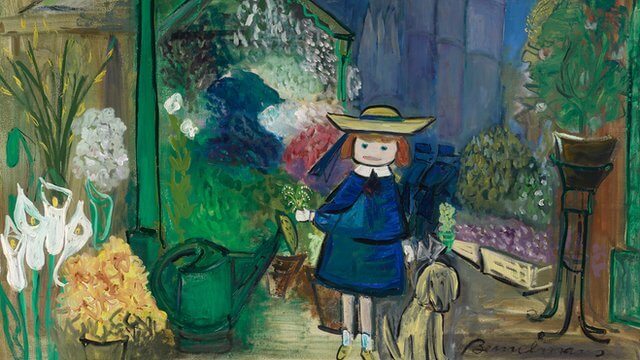The Loneliness of Madeline

Just outside the entrance to “Madeline in New York,” the New York Historical Society’s Ludwig Bemelmans show, sits a Madeline doll in a glass case. A bright yellow hat and boxy, red-yarn hair frame her round face. Her smile is a curved red line, slightly askew. Out of her chic, long blue coat peeks her scarf and, below, her black shoes. As soon as I saw her, the tears began.
I had that Madeline doll; I could see her sitting on the shelf of my childhood bedroom, back pressed to flower-patterned wallpaper. I’d had the same reaction, watching Richard Linklater’s Boyhood, to the image of a young Sam swatting at her little brother Mason with a pillow. I, too, am a big sister. The abrupt nostalgia—being yanked back to childhood like a caught fish—was overwhelming; it registered as physical pain.
Was I mourning the loss of childhood? Crying, maybe, that I might never be that joyful again? Or was I crying because I wasn’t that joyful a child, not really? Was it that dolls were my good friends, and Madeline reminded me of this lost comfort—or that she underscored how sad that reliance was?
Madeline was published 75 years ago, in September 1939, the week World War II broke out. The summer of the previous year, Bemelmans had been knocked off a bike on Ile D’Yeu, off the French coast. In the hospital, he chatted with a young appendectomy patient. He sketched a few ideas on the way home and, back in New York, these morphed into Madeline, the story of a wily young girl at a boarding school in Paris who is struck with appendicitis in the night.
Bemelmans’ father abandoned the family in Austria in 1904, the exhibit has it, and his mother moved the family to Germany. Bemelmans did poorly in school and, faced with the possibility of reform school, chose America instead. At 16, in 1914, he docked, his father forgot to meet the boat, and he spent the night on Ellis Island. By the next year, he’d joined the staff at the Ritz-Carlton, where he started cartooning in the 1920s, using a ballroom as his studio.
“Confident and charismatic, Madeline is a heroine who faces life’s vicissitudes with aplomb—just as her creator did,” reads a panel of the exhibition’s wall text. I know little about Bemelmans other than what I learned from this show, which leaves ample room for identification and projection—and what struck me was the darkness that emerged alongside this cheerful proclamation. Such as this quotation, from Bemelmans: “For me, Madeline is therapy in the dark hours when the black cosmic cloud sinks down.” Or, on innkeeping: “It’s the ideal life because you are never alone.”
I am a lonely person. I believe the seed was planted early, and over time sprouted into a full-grown plant. I’ve countered this hollowness with variously shaped fantasies in which I have constant company. As a child, I clung to Sidney Taylor’s All-of-a-Kind Family series, especially the first book, which I reread and reread. Ella, Henny, Sarah, Charlotte, and Gertie were five Jewish sisters growing up in an early twentieth century New York City tenement. The girls trooped to the library, to the candy store, to Rivington Street market, to Papa’s shop, always en masse. “Gertie was glad it was twelve o’clock. It had been so lonesome in the house all morning without her sisters,” begins one chapter. “They’ll be home any minute now, she thought happily as she helped Mama set the table for lunch.”
Despite being prepubescent, I dreamt of having my own brood. Six children, preferably; four at the absolute minimum. I spent a good deal of time wishing I had been born in a previous era, when (in my imagination) I would’ve had access to a community of people at all times. For a good few years, I nursed a fantasy of moving to Israel to live on a kibbutz.
The girls in Madeline’s boarding school are never alone. They break their bread together, they sleep in the same room, they walk about town in their two straight lines, they even smile and frown as one. Their company is comfort. Their routine is comfort. Loneliness, fear, and sadness are big feelings, and these external containers are a helpful antidote. A child might read Madeline over and over, incorporating the characters’ routine into her own.
Madeline, of course, stands apart. While her classmates walk over a bridge in their two straight lines, Madeline teeters on the wall alongside them, frightening Miss Clavel. At the zoo, the girls cling to Miss Clavel in the face of a roaring tiger; Madeline just says, “Pooh-Pooh.” And in the hospital, when her classmates aren’t visiting, she convalesces alone.
But her literal remove comes within a stable context. There is the narrative structure of the book: every picture is accompanied by text, which rhymes. Routine, predictability. There is also the safe fictional universe in which Madeline exists. Miss Clavel, the girls’ caretaker, embodies maternal instinct; the girls’ actual mothers are absent. “In the middle of one night / Miss Clavel turned on her light / and said, ‘Something is not right!’” She runs into the girls’ room to find Madeline in pain. It’s the fantasy of the ideal mother, and of complete merger: the child need not express her needs, because the mother can intuit them. Soon after, Madeline is whisked off to the hospital by Dr. Cohn: “Madeline was in his arm / in a blanket safe and warm.” A secure launch pad is what makes individuation possible.
In the middle of the NYHS exhibit is a couch, and I nestled into the corner, reading Madeline through—the books were laid out on a coffee table—and tearing up all over again. In the end, Miss Clavel finds the children crying that they want appendicitis, like Madeline. It’s a bit of a joke, as they’ve seen Madeline surrounded by toys and candy in her hospital bed. And, on an only slightly less literal level, it’s a way of making something scary, appendicitis, not so scary after all.
But to my mind, the girls’ tears are also rooted in loss. Madeline has left their womb-like enclosure. She represents the possibility that, one day, they too must venture out on their own. But we won’t have to see it:
“Good night, little girls!
Thank the lord you are well!
And now go to sleep!”
said Miss Clavel.
And she turned out the light—
and closed the door—
and that’s all there is—
there isn’t any more.
The loop is closed. The girls are safe, in their beds forever, and so are we.
Except not: Bemelmans couldn’t let Madeline die. In the ‘50s, he published Madeline’s Rescue, then Madeline and the Bad Hat, then Madeline and the Gypsies, and on. After Bemelmans’ death, his grandson, John Bemelmans Marciano, continued the series. We want Dr. Cohn’s tightly wrapped blanket of security; we want to know exactly what comes next. But then again, we don’t. In any case, we have no choice: we must grow up.
Jessica Gross is a freelance writer based in New York City.
You might also like 



















